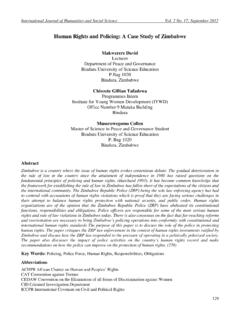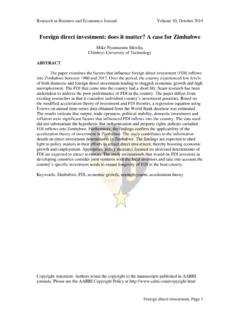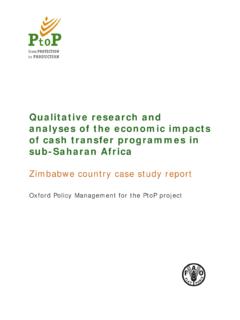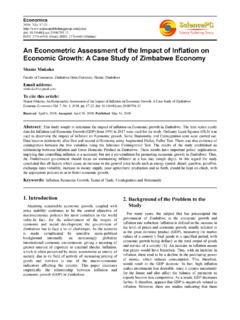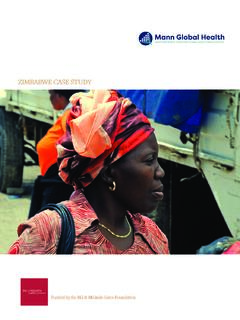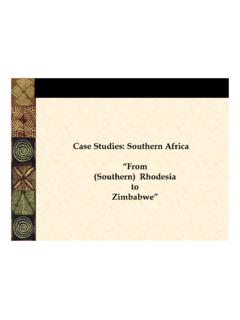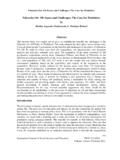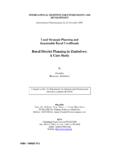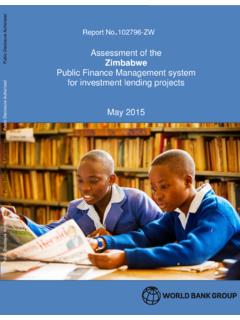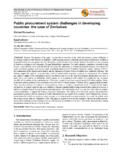Transcription of Seed Policy Harmonization in SADC and COMESA: The Case …
1 WORKING PAPER seed Policy Harmonization in SADC and COMESA: The case of zimbabwe Co-authored by Yuan Zhou and Katrin Kuhlmann1 Syngenta Foundation for Sustainable Agriculture September 2015 The paper is part of a series of research on regional seed Policy Harmonization in Africa, to assess the process for implementing a seed regulatory system that can better deliver improved seed varieties to farmers. It is part of Syngenta Foundation s Seeds2B initiative. 1 Yuan Zhou is Head of Research and Policy Analysis at Syngenta Foundation for Sustainable Agriculture, Basel, Switzerland, Katrin Kuhlmann is the President and Founder of the New Markets Lab, Washington DC.
2 Executive Summary High-quality seed is fundamental to enhancing agricultural productivity, food security, and rural livelihoods, and the legal and regulatory environment is a significant factor impacting the availability and accessibility of improved seed . Although national and regional frameworks governing seed have been strengthened, implementation of these frameworks is a critical challenge throughout sub-Saharan Africa. This case study on zimbabwe is the second in a series by the Syngenta Foundation for Sustainable Agriculture and its partner the New Markets Lab to assess regional seed Harmonization throughout sub-Saharan Africa, which holds great promise for strengthening seed regulatory systems so that they can better respond to market demands and deliver improved seed varieties to farmers.
3 These case studies are part of a larger project on regional seed Harmonization launched by the partners in 2014 that includes a comparative assessment of regional Harmonization efforts in seeds and case studies focused on how individual countries are implementing regional seed frameworks. As a next step, the partners will conduct test cases to work through the regulatory process in several of Africa s regions. Three case studies will be done in total; one examining Kenya (a member of EAC and COMESA), another assessing a country in ECOWAS, and this case study on zimbabwe (a member of COMESA and SADC). All of the case studies in this series assess the legal and regulatory framework on seed at the country level, highlight progress on implementing regional seed protocols, and identify recommendations on how to support efforts already underway to strengthen the seed enabling environment to develop an inclusive and effective seed system.
4 Although each case study can stand alone, the series will enable comparison of regulatory practices across several countries, which will strengthen understanding of how implementation of regional seed initiatives can contribute to a well-functioning seed regulatory system. This case study focuses on the legal and regulatory environment for seeds in zimbabwe , as a critical factor in ensuring that sufficient high-quality seed is available in the market. It assesses three aspects of the legal and regulatory system: variety release and registration, certification, and cross-border trade. Company interviews are included below and provide a method for examining zimbabwe s legal and regulatory system in practice.
5 Based on the authors findings, zimbabwe has developed notable regulatory best practices in some areas (for example variety release and registration and certification) that could perhaps be applied in other areas in which processes are more complex (cross-border trade) in order to increase availability and access of high-quality seed . 1 Overview of the Zimbabwean seed System zimbabwe s agricultural sector has long been central to the country s economic development, and nearly 70 percent of the population relies upon agriculture for livelihood directly and indirectly. Prior to land reform in 2000, zimbabwe s agricultural GDP had increased steadily every year and reached billion USD (in constant 2005 terms) in 2000, accounting for 18 percent of the total GDP.
6 Fast-track land reform program began in February 2000, characterized by reallocating land from large farm owners and redistributing it in the form of small-scale holdings. The effects of zimbabwe s land reform are far-reaching and well documented, and one effect of land reform has been a contracted seed sector in zimbabwe . Between 2002 and 2004, many seed producers moved, and the government began to import seed as a result. Commercial seed production on large farms was impacted, and small-scale seed growers could not produce sufficient quantity of seeds to meet domestic demand. Since the land reform in 2000, demand for high quality seed has only increased, however (Mujaju, 2010). Approximately percent of farmers access seed from regional seed distributors or seed company depots, percent from government programs, percent from farmers and farmer groups, percent through NGOs and relief programs, percent from rural stockists, and percent through contractors (TASAI, 2015).
7 Of all the staple food crops, maize is highly critical because of its significant role in food security. It is estimated that the zimbabwe market requires at least 50,000 tons of high quality hybrid seeds per annum (Mujaju, 2010). Because the seed industry struggles to meet local demand, imports are much more of a factor. zimbabwe s seed sector has historically included private seed companies, and several large companies dominate the market. As evidenced by the number of breeders, varieties released, quantities sold per season, and number of active companies producing and marketing the seed , maize seed is dominant. zimbabwe s seed market is growing steadily, with major support of the private sector in the areas of development and varietal introduction, elements of certification, and production and marketing of seed .
8 The following subsections provide a brief overview of zimbabwe s seed market, while the next section describes in more detail the Zimbabwean legal and regulatory process for seed registration, certification, and cross-border trade. Plant Breeding and Varietal Improvement Both seed companies and public research institutions carry out plant breeding in zimbabwe . seed companies are leading breeding efforts for the major crops (maize, 2 cotton, soybean, and sorghum), and about 80 percent of the active breeders are employed in the private sector (TASAI, 2015). Approximately ten seed companies have their own breeding programs, while the rest depend upon national breeding programs or international breeding organizations like the International Maize and Wheat Improvement Center (CIMMYT) and International Crops Research Institute for the Semi-Arid Tropics (ICRISAT) to get new varieties and foundation seeds.
9 The national institutions most involved in research and breeding are the Crop Breeding Institute (CBI), the Cotton Research Institute (CRI), and zimbabwe Technological Services Scientific Industrial Research & Development Center (ZTS-SIRDC). Maize seed dominates the breeding efforts; currently there are 21 active maize breeders across the private and public sector (TASAI, 2015). Overall, zimbabwe has 40 active breeders, with 35 varieties released in the last three years, compared to South Africa with 310 released varieties, Kenya with 60 released varieties, and Uganda with 19 released varieties (TASAI, 2015). seed Co Ltd., Pannar, Pioneer, and Quton lead the breeding efforts for maize, soybean, sorghum, and cotton, along with 10 other medium and large seed companies (TASAI, 2015).
10 Variety Maintenance and Early Generation seed Multiplication Breeders of quality seed must keep nucleus seed , or very high-quality seed , in order to produce and multiply seed that maintains its varietal characteristics throughout generations. Early generations of seed are called pre-basic and basic seed (or sometimes breeder and foundation seed ). To multiply early generation seed , the producer must have a high degree of technical expertise as well as the right equipment and infrastructure. The breeder often oversees the multiplication of early generations of seed . Research organizations primarily produce and distribute foundation seed for new crop varieties and depend upon the private sector or registered seed companies to multiply and market seed .

